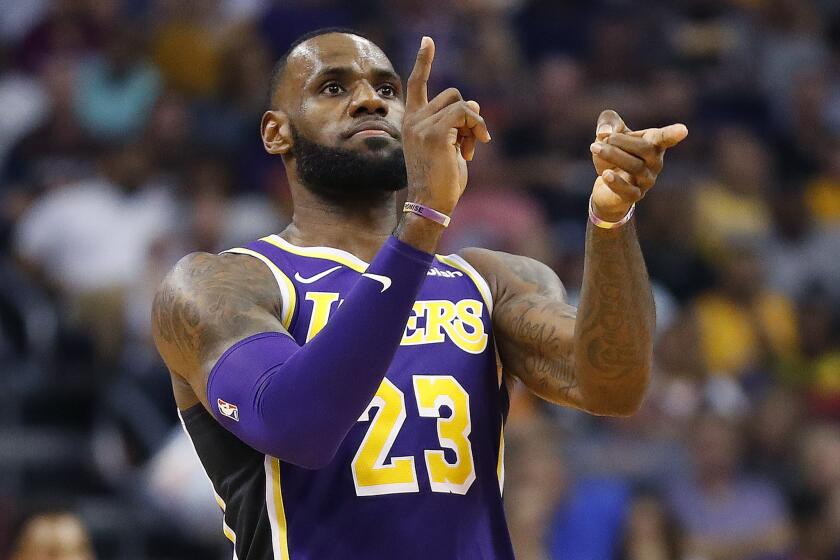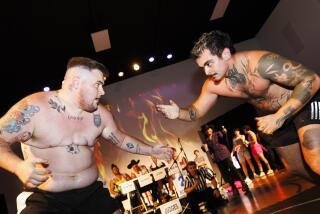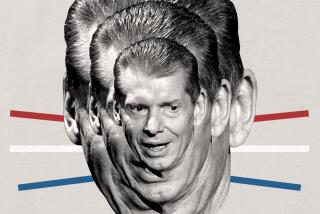Column: The Undertaker’s long career is the subject of WWE docuseries ‘The Last Ride’
- Share via
The first time I ever saw “The Undertaker” perform, I was 11 and my dad took me to the old Sports Arena to watch the WWE star face Sid Justice in a “casket match.” In hindsight, an interesting way for father and son to bond.
The Undertaker has long been one of pro wrestling’s biggest stars, and while I felt I knew the performer, I knew little about Mark Calaway, the man who has played the character since 1990.
Given the opportunity to interview him over the phone this week led to an uncomfortable question I’d never asked anyone before: “What exactly should I call you?”
“Mark is fine, ‘Taker is fine, whichever one works for you, sir,” Calaway said. He laughed. “Most of the guys call me ‘Taker, but I’m getting more used to Mark now. But whatever you want, I’m good.”
So strange. Within 10 seconds, the emotionless character nicknamed “The Dead Man” for most of my youth, called me sir, laughed -- The Undertaker does not laugh -- and told me to call him whatever I wanted.
As “The Last Dance,” the 10-part documentary on Michael Jordan and the Chicago Bulls, comes to and end Sunday, “The Last Ride,” a five-part docuseries on The Undertaker, will begin with the first two episodes airing Sunday on the WWE Network.
An NBA champion this season wouldn’t deserve an asterisk, but the Lakers would have earned some kind of symbol if they won after the coronavirus shutdown.
The project has been in the works for three years, so the timing is coincidental -- but perfect for anyone who remembers watching The Undertaker make his WrestleMania debut in Los Angeles in 1991 and Jordan make his NBA Finals debut against the Lakers just a couple of months later.
“I’ve been watching ‘The Last Dance’ every Sunday and it’s been really good,” Calaway said. “And now maybe ‘The Last Ride’ is something people can watch on Sundays. As big a sports fan as I am, I can only watch the 1988 World Series and the 1991 NBA Finals so many times.”
The documentary marks the first time Calaway has pulled back the curtains on arguably the most popular character in professional wrestling history.
“Only the people in my personal life got Mark Calaway. At work it was always The Undertaker,” Calaway said. “We all know I have far more matches behind me than I do in front of me, and I had the mindset three years ago going into WrestleMania in Orlando that it could possibly be my last match, so I felt like I wanted to document all the raw emotion around that. We didn’t set out to make a documentary, but I wanted to capture my last few days doing this. The next thing you know, three years later, I’m still doing this, and we have all this amazing footage.”
In an era where wrestlers openly talk about character development, storylines, gimmicks and creative differences with writers, Calaway was the last WWE performer to defend “kayfabe,” wrestling lingo for protecting the secrets of the business. Calaway still struggles with it as he talks about the documentary, which not only highlights his career but his personal life at home with his wife and children.
Everyone wants to know what’s going on behind the scenes and I’m the last to do it,” he said. “I’m a dinosaur. I love kayfabe. I wanted to protect the business and protect The Undertaker character, but it died somewhere along the way and you can’t put the toothpaste back in the tube.”
The first two episodes of the docuseries shows a vulnerable side of Calaway as he struggles with the physical pain of being in the ring over three decades, including what happened behind the scenes with his hip surgery, and candid conversations with WWE chairman and CEO Vince McMahon, who he views as a second father.
“It’s funny when people actually do meet me because people have all these preconceived ideas, because they only know what they’ve seen on TV,” Calaway said. “They think I’m this ghoulish guy, but then they hear my normal voice and see that I can actually string more than one or two sentences together. I’m a pretty fun-loving guy actually, and I like to cut up and I try not to take life too seriously.”
Professional sports, including pro wrestling, has been considered an “essential service” in Florida during the COVID-19 pandemic. The WWE has continued its schedule of weekly televised shows over the past two months, albeit without fans inside of the company’s performance center in Orlando.
WrestleMania 36, which was scheduled for last month at Raymond James Stadium in Tampa, Fla., was moved into the WWE Performance Center and turned into a two-night event. The Undertaker, famous for his 21-match WrestleMania winning streak, defeated A.J. Styles in a “boneyard match,” the main even of the first night. It was shot on a closed set off-site in Orlando and looked more like a film than a wrestling match.
“I knew when we did it, it was going be well-produced, but you don’t know until it’s all put together,” Calaway said. “It felt good. I feel like I’m a story-teller in a wrestling match and that match had great story-telling.”
The Undertaker will celebrate his 30th anniversary in the WWE this fall, and Calaway is still looking for a storybook end to his career. His first WrestleMania match took place in Los Angeles in 1991 and next year’s WrestleMania is scheduled to take place at SoFi Stadium, the new $5-billion home of the Rams and Chargers.
Could he end his career and WrestleMania run in the city where it started?
“That’s interesting,” he said. “I might have to think about that.”
More to Read
Go beyond the scoreboard
Get the latest on L.A.'s teams in the daily Sports Report newsletter.
You may occasionally receive promotional content from the Los Angeles Times.












